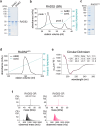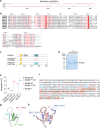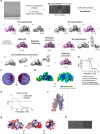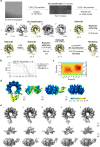Mechanism of single-stranded DNA annealing by RAD52-RPA complex
- PMID: 38658755
- PMCID: PMC11096129
- DOI: 10.1038/s41586-024-07347-7
Mechanism of single-stranded DNA annealing by RAD52-RPA complex
Abstract
RAD52 is important for the repair of DNA double-stranded breaks1,2, mitotic DNA synthesis3-5 and alternative telomere length maintenance6,7. Central to these functions, RAD52 promotes the annealing of complementary single-stranded DNA (ssDNA)8,9 and provides an alternative to BRCA2/RAD51-dependent homologous recombination repair10. Inactivation of RAD52 in homologous-recombination-deficient BRCA1- or BRCA2-defective cells is synthetically lethal11,12, and aberrant expression of RAD52 is associated with poor cancer prognosis13,14. As a consequence, RAD52 is an attractive therapeutic target against homologous-recombination-deficient breast, ovarian and prostate cancers15-17. Here we describe the structure of RAD52 and define the mechanism of annealing. As reported previously18-20, RAD52 forms undecameric (11-subunit) ring structures, but these rings do not represent the active form of the enzyme. Instead, cryo-electron microscopy and biochemical analyses revealed that ssDNA annealing is driven by RAD52 open rings in association with replication protein-A (RPA). Atomic models of the RAD52-ssDNA complex show that ssDNA sits in a positively charged channel around the ring. Annealing is driven by the RAD52 N-terminal domains, whereas the C-terminal regions modulate the open-ring conformation and RPA interaction. RPA associates with RAD52 at the site of ring opening with critical interactions occurring between the RPA-interacting domain of RAD52 and the winged helix domain of RPA2. Our studies provide structural snapshots throughout the annealing process and define the molecular mechanism of ssDNA annealing by the RAD52-RPA complex.
© 2024. The Author(s).
Conflict of interest statement
The authors declare no competing interests.
Figures
















Similar articles
-
Dynamic regulatory interactions of rad51, rad52, and replication protein-a in recombination intermediates.J Mol Biol. 2009 Jul 3;390(1):45-55. doi: 10.1016/j.jmb.2009.05.009. Epub 2009 May 13. J Mol Biol. 2009. PMID: 19445949
-
DNA annealing by RAD52 protein is stimulated by specific interaction with the complex of replication protein A and single-stranded DNA.Proc Natl Acad Sci U S A. 1998 May 26;95(11):6049-54. doi: 10.1073/pnas.95.11.6049. Proc Natl Acad Sci U S A. 1998. PMID: 9600915 Free PMC article.
-
Rad52-mediated DNA annealing after Rad51-mediated DNA strand exchange promotes second ssDNA capture.EMBO J. 2006 Nov 29;25(23):5539-48. doi: 10.1038/sj.emboj.7601412. Epub 2006 Nov 9. EMBO J. 2006. PMID: 17093500 Free PMC article.
-
Replication protein A: single-stranded DNA's first responder: dynamic DNA-interactions allow replication protein A to direct single-strand DNA intermediates into different pathways for synthesis or repair.Bioessays. 2014 Dec;36(12):1156-61. doi: 10.1002/bies.201400107. Epub 2014 Aug 29. Bioessays. 2014. PMID: 25171654 Free PMC article. Review.
-
Molecular pathways: understanding the role of Rad52 in homologous recombination for therapeutic advancement.Clin Cancer Res. 2012 Dec 1;18(23):6400-6. doi: 10.1158/1078-0432.CCR-11-3150. Epub 2012 Oct 15. Clin Cancer Res. 2012. PMID: 23071261 Free PMC article. Review.
Cited by
-
A structural phylogenetic tree of Rad52 and its annealase superfamily.Comput Struct Biotechnol J. 2024 Dec 24;27:360-368. doi: 10.1016/j.csbj.2024.12.012. eCollection 2025. Comput Struct Biotechnol J. 2024. PMID: 39897054 Free PMC article.
-
Oxidative stress at telomeres triggers internal DNA loops, TRF1 dissociation, and TRF2-dependent R-loops.Nucleic Acids Res. 2025 Apr 10;53(7):gkaf285. doi: 10.1093/nar/gkaf285. Nucleic Acids Res. 2025. PMID: 40219969 Free PMC article.
-
Communication between DNA polymerases and Replication Protein A within the archaeal replisome.Nat Commun. 2024 Dec 30;15(1):10926. doi: 10.1038/s41467-024-55365-w. Nat Commun. 2024. PMID: 39738083 Free PMC article.
-
Impact of glycolysis enzymes and metabolites in regulating DNA damage repair in tumorigenesis and therapy.Cell Commun Signal. 2025 Jan 23;23(1):44. doi: 10.1186/s12964-025-02047-9. Cell Commun Signal. 2025. PMID: 39849559 Free PMC article. Review.
-
DNA repair and the contribution to chemotherapy resistance.Genome Med. 2025 May 26;17(1):62. doi: 10.1186/s13073-025-01488-8. Genome Med. 2025. PMID: 40420317 Free PMC article. Review.
References
MeSH terms
Substances
Grants and funding
LinkOut - more resources
Full Text Sources
Molecular Biology Databases
Research Materials
Miscellaneous

